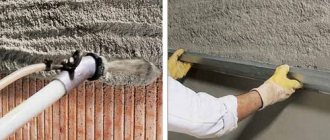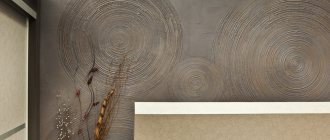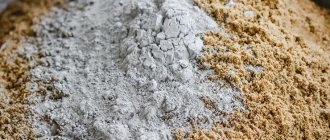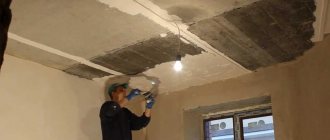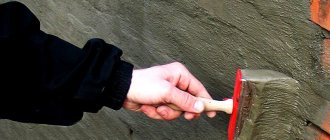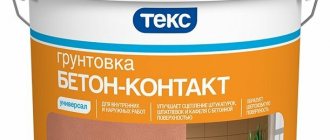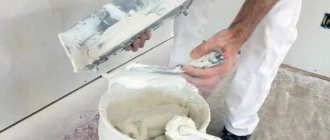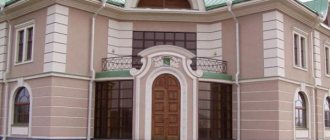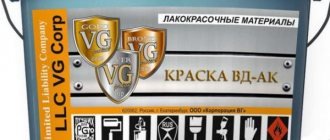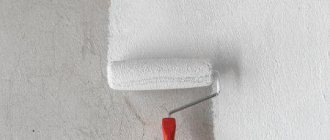Concept and features.
Plaster is a hardened layer of mortar that is used for finishing residential and commercial premises. Conventional solutions are used to prepare surfaces for decoration, as well as to protect the facade from unfavorable environmental conditions that are destructive. Special solutions are used when it is necessary to create the following coatings:
- Shielding membranes.
- Partitions.
- Isolation of surfaces from penetration of various types of radiation.
Solutions for decorative purposes are used when finishing structures in order to increase their aesthetic appeal.
Plaster is used during construction work to level the surfaces of the room, as well as for decorative purposes. It can create an imitation of brickwork. Often, when using piece materials for construction, joints are formed, which can best be hidden by the cement type of plaster.
Solutions of various colors are used to add coziness to rooms. Decorative cement plaster is intended not only to mask uneven walls or ceilings, it also has good sound insulation properties and helps retain heat in the room.
It is often used to provide fire resistance to the walls of industrial and residential buildings.
What to choose for finishing?
In order to finally understand which plaster is better, gypsum or cement, you need to understand their key differences and the features of each of them. For example, today there are many options and modifications of plaster solutions, depending on the ingredient that forms its basis.
Thus, a cement mixture for plastering walls assumes the presence of cement, but it can be replaced completely or in certain quantities by other substances:
There are a large number of possible options, but the most popular are usually plaster mixtures containing cement or gypsum for finishing walls and other surfaces.
This material is characterized by first-class strength and durability. The proportions of the components of cement plaster may differ, depending on the base substance included in its composition. So, in addition to the constant components that, one way or another, are used in each solution (cement, water), cement plaster for interior work, as well as that used for exterior decoration, can be based on sand or lime.
The resulting sand-based building material is usually made using proportions of four parts cement to one part sand, with water added to bring the mortar to a workable consistency. A similar mixture is used to seal cracks and depressions in the walls of the interior of buildings, and also as facade cement plaster to form smooth surfaces with regular angles.
Properties and characteristics of cement plaster
The main structural component is cement, made from finely divided gypsum and clinker. Clinker complies with GOST 530-2012 and is a product obtained by firing clay, predominantly calcium silicate, and a mixture of limestone.
Specifications
- Application thickness – 0.5-4 cm (in 1 pass);
- The grade of cement used for the mixture intended for interior work is M100-M300;
- Compressive strength – 6-12 MPa;
- Peel adhesion – 0.3-0.4 MPa;
- Water holding capacity 90-95%;
- Consumption of dry suspension when applied to the base of 1 cm layers is 12-20 kg/m2;
- Water consumption – 150-400 ml/kg;
- Viability of the finished mass – 30-360 minutes;
- Temperature conditions for work: +5-+30°С;
- Frost resistance – 50 cycles;
- Complete hardening time – 10-30 days;
- Gluing tiles – 3 days.
Hidden and obvious benefits.
To compensate for the main disadvantage of sand mixtures - their significant weight, slaked lime is added as the main component. The composition of facade cement plaster with the addition of lime also includes Portland cement, additives with water-retaining properties, quartz sand of various fractions and others.
Such cement plaster provides the necessary microclimate and humidity level for the structures being built, and is also characterized by good ability for high-quality adhesion to the surface on which it is applied.
The benefits that this mixture has are quite extensive. Firstly, it is very durable, which makes it possible to carry out repairs after its use much less frequently. Secondly, a high degree of adhesion - adhesion to the surface, ensures long-term preservation and no need to add accompanying additives to increase its strength. Cement plaster, the preparation proportions of which do not require expensive or rare materials, is affordable.
Gypsum plaster is convenient for use on surfaces that do not tolerate the cement type. These can be painted walls or areas of surfaces made of plastic or wood. It also does not require such a professional and multi-stage approach during application as cement.
Thus, this material is better suited for finishing facades, wet and damp rooms that are exposed to humidity. Gypsum can help in finishing surfaces on which cement simply does not adhere. This advantage is used when working with wooden, polymer, clay or ceramic surfaces.
Varieties and recipe
At the moment, two types of cement-based plasters are most widely used. Their technical and operational characteristics are somewhat different from each other, which determines the optimal area of their application and application methods.
Cement-sand mixtures
The binder is mainly Portland cement grades M150-500. As a rule, grades up to M300 are used for interior work in dry rooms, M350 and higher are used in compositions for facade work and rooms with high humidity - bathroom, kitchen, etc.
The ratio of sand and cement for plaster depends on the fraction, the required final strength or the area of application. For example, to apply a middle (ground) layer, you need sand of medium fractions of 0.5-1 mm with a minimum content of clay or silt deposits. Fine sand is used for coating (finish plastering).
Cement mortar for plastering walls, proportions depending on brand
Special additives give the cement-sand mixture for plaster additional properties:
- Quartz sand and diabase flour – acid resistance;
Quartz sand
- Barite and serpentite sands with a fraction of at least 1.25 mm – protection from X-ray radiation;
- Metal shavings or dust added to the cement mortar gives it additional strength and increased toughness;
- Marble flour and coarse sands 1.5-4 mm are decorative facade coatings.
Colored coarse sand for decorating facades
Various types of sand-cement plaster
| Coverage type | Type of plaster | |||
| Cement-sand | Cement-lime | |||
| Cement | Sand | Lime | Sand | |
| Splash | 1 | 2,5-4 | 0,3-0,5 | – |
| Priming | 1 | 2-3 | 0,7-1 | 2,5-4 |
| Covering | 1 | 1,1,5 | 1-1,5 | 1,5-2 |
- Simple - only 2 types of work are performed, spraying and soil without the use of beacons. It is used in internal technical rooms: garages, basements, attics, where aesthetics are not important. The main purpose is to seal bare brick walls.
- Improved - a covering is added to the previous layers, which must be rubbed with a special trowel or grater. Most common when finishing residential premises or external walls.;
- High quality - produced according to beacons. Apply at least 5 layers (2-3 layers of primer). Ironing with cement is used for covering, which significantly increases the moisture resistance of the surface.
Instructions for preparing sand-cement mixture
- First we sift the sand. For wet use a sieve with holes up to 4 mm for dry 2 mm;
- 2-3 liters of water are poured into the container, cleared of the remnants of previous batches;
- Cement is added and thoroughly mixed until there are no lumps;
- Based on the proportions given in the tables, the required amount of sand and other fillers and modifiers are added;
- The mixture is thoroughly kneaded until a homogeneous mass is obtained, water or a little sand is added if necessary.
Important: to increase the plasticity of the plaster, add 30-50 ml of detergent to the water before the cement, which is thoroughly mixed in the water.
The solution has the correct density if a hole of 2-3 cm remains after the mixer is pulled out.
Cement-lime mixtures composition and features
To reduce the weight of cement-sand plaster, slaked lime was added to its composition. If slaking is carried out independently, then the minimum period of aging of lump lime is 2 weeks. Otherwise, there is a risk of swelling and peeling of the finish. A properly prepared solution has high strength and vapor permeability.
Important: when preparing lime mass yourself, you should not use plastic containers. The quenching reaction occurs with the release of a large amount of heat.
Advantages and disadvantages
The main advantages include:
- Good adhesion to most materials: concrete, brick, foam block, wood;
- Antibacterial properties – prevents the formation of fungus and mold;
- Good plasticity of the mixture during the entire life cycle;
- High vapor permeability creates a comfortable indoor microclimate;
- The plastered surface is resistant to mechanical abrasion.
The disadvantages include:
- Reduced resistance to impacts and stretching/compression;
- The cost is slightly higher than that of simple one-component mixtures.
Table of proportions of cement-lime plaster ingredients
How to prepare cement plaster for interior work with your own hands.
When preparing a solution, it is important to understand that it traditionally consists of three elements:
- The first of which is necessary to bind the others (this is often cement, lime or clay).
- The second component acts as a filler and gives the main weight to the material (usually sand).
- The third element is water.
It is undesirable to violate the proportion when preparing the solution yourself. The optimal solution is to combine binders and filler components in equal parts.
Features of the technology.
In order to carry out plastering work yourself, you need to stock up on the following tools:
- Device for throwing on a wall.
- Leveling tool.
- Spatula for grinding the solution.
Before applying the prepared mixture, it is advisable to prime the surface to be treated or simply moisten it with water so that the liquid from the solution does not penetrate into the porous structure of the surface. When the stretched and leveled layer applied with a trowel dries, it’s time to grout.
To do this, using a polisher, apply a solution of a thinner consistency to the surface to be treated for final leveling.
The layer of plaster can be strengthened with reinforcement using a special mesh. Also, the dried layer can be etched with special preparations to prevent the development of fungi in it. When performing all this work, you must not forget about safety rules. To do this, you need to protect your hands with gloves, use a respirator or mask, a work gown, and work in a ventilated room.
The dried solution acquires final hardness approximately a month after application. Cracks may appear due to artificial acceleration of drying using blowing machines.
How to make functional and aesthetic repairs.
Decorative plaster is often used to give rooms and building facades additional aesthetic appeal. This technology is relatively cheap and can be applied in practice with one’s own hands.
We buy ready-made ones.
Knauf cement plaster is universal in color range. So, in particular, you can buy both white cement plaster and materials of intermediate shades, up to gray. Such differences in color are explained depending on the content of inorganic elements or compounds in the gypsum stone.
Knauf is ideal for treating concrete surfaces and eliminates the need for puttying. Knauf is represented by brands of more than ten names, which allows you to choose the one that will ideally fulfill the task assigned to it.
One of the types of Knauf plasters is Rotband cement plaster, which has a number of advantages over others. So, in particular, its consumption when processing surfaces is half as much as other similar options. In addition, it is safe and does not interfere with the penetration of steam, and also does not deform when applied in a thick layer. Rotband has found application in restoration work, as well as as decorative cement plaster.
Cement plaster KREPS is used when processing uneven surfaces. It can be cement and gypsum and is used when it is necessary to create a high-quality coating of surfaces with varying degrees of adhesion. It can be applied either manually or using special automatic mechanisms.
Some types of this plaster can be supplemented with modified additives of minerals and polymers to increase its plasticity. Kreps, as a facade cement plaster, has a fine-grained base and, after hardening, is highly resistant to frost.
Flaws
The composition is not without several drawbacks, the most significant of which is the large weight of the finished solution, which creates an additional serious load on the plane.
Another drawback is the labor-intensive finishing work, which involves applying cement plaster in several stages, which also affects the implementation time of the rough layer.
In addition, the mixture itself reaches its maximum strength only after 3-4 weeks. Failure to follow the mixing instructions will inevitably lead to cracking of the applied layer.
The material is incompatible with plastic, previously painted, or other smooth or wooden surfaces. Even with a very smooth concrete base there can be some difficulties.
It should also be remembered that cement-based plaster for interior work requires additional putty. Such solutions are not suitable for final finishing.
Main types of decorative cement plasters
Let's look at the main types of plasters used in private construction and finishing.
Microcement
In fact, this is the marketing name for polymer cement plaster, which has been actively promoted recently. It is a polymer-cement composition based on high-quality, finely ground Portland cement and a polymer binder (most often a water-based acrylic dispersion is used, which gives the coating excellent adhesion, environmental friendliness and strength).
For additional effects, crumbs of various types of stone and pigments are added to the microcement mixture.
This coating is characterized by a high degree of wear resistance and moisture resistance; it can be used as a floor covering for highly loaded rooms, for finishing the walls of wet rooms (showers, bathrooms, swimming pools) and facades. Apply a layer of up to 1.5 mm.
Cement-lime plaster
The most common type of decorative cement plasters. It consists of Portland cement (most often white, or tinted), lime binder with pigments for tinting and decorative filler (quartz, marble, tuff or fine lime sand).
Due to the high plasticity of the material, which it retains for a sufficient time for work, a variety of tools are used to finish the coating layer of such plaster: textured rollers, stamps, templates, trowels, Venetian spatulas, brushes, brushes, brooms, etc. All this allows you to create Such plaster can be used to create almost any texture and pattern and imitate various materials.
Spraying and priming are carried out in the same way as with conventional plaster, taking into account only the increased plasticity and low rigidity of the material due to the absence of coarse aggregate.
The decorative effect of the material is determined by the covering, most often in two layers. The first layer is made more liquid and applied to the finished primer in a thin layer of 2 mm to improve the adhesion of the final coating layer to the primer.
Allow the first layer to set for about 2 hours and apply a second layer of a thicker consistency, 5 mm thick, to compact and form a pattern.
The use of CEMMIX additives makes it possible to obtain plasters (including decorative ones) with improved technical characteristics: strength, frost resistance, water resistance, etc.
And also provide the necessary parameters of the plaster mortar, taking into account the technology of performing the work: increasing ductility, accelerated strength gain, carrying out work at low temperatures, etc.
The main thing is to keep in mind that almost all additives have a natural dark color, which can negatively affect the color or decorative effect of the plaster when mixed with the addition of finishing layers.
For detailed advice on the use of Cemmix additives in decorative cement plaster, we advise you to contact our hotline by phone 8
Terrasite plaster
Similar to cement-lime plaster, it differs from it in the large fraction of filler, which is exposed during grouting, forming the color and pattern of the coating.
This is a plaster mixture based on white Portland cement (obtained by grinding clinker based on pure lime and white clay, with a small content of iron oxide), light quartz sand of fine fraction, marble or limestone flour, pigments and decorative filler (crushed mica, glass, large colored quartz sand ).
There are mixtures of terrasite plaster of three fractions:
- Fine: 1 – 2 mm
- Medium: 2 – 4 mm
- Large: 4 – 6 mm
The application method is as follows - after a layer of spray (performed with ordinary cement plaster to save money), a layer of soil is applied from terrazite and the texture of the coating is formed by going through the pattern with steel combs or brushes.
Then a layer of covering from the same terrazite is applied and rubbed over. After the initial setting of the plaster (when it still retains its plasticity), finishing treatment is carried out - using a roller, a metal brush or scrapers, the surface is rubbed so that the decorative filler appears.
After this, the plaster is cleaned of dirt using a brush, brush or broom and left for final hardening, periodically wetting the surface for 3-5 days.
Coatings containing polystyrene
The use of plasters containing polystyrene is suitable for external and internal treatment of premises. Such lightweight mixtures have excellent thermal insulation properties and can withstand significant temperature fluctuations. Also, coatings with polystyrene are vapor permeable and are not subject to cracks on the surface, which is ensured due to the low elasticity coefficient.
It is very simple to process and apply light plaster with polystyrene to walls, but, unfortunately, it is used much less frequently than solutions with perlite. This is explained by the fact that the polystyrene coating is flammable and at the same time emits substances harmful to health. Therefore, such a coating after application should be additionally protected with non-flammable materials.
Plaster On White Cement
- LaStroy Posted on 07/17/2018CementNo Comments
Facade and interior plasters
Cement-based plaster “Bark beetle” or “Bark beetle “Rain”
Decorative plaster based on snow-white or colored cement with mineral fillers and special additives that improve adhesion to the base. The size of the drawing stone is 1.5mm, 2mm, 3mm. Plaster is used for interior and exterior work, and can be used as a decorative coating in insulation systems over a previously plastered layer.
The plaster solution is applied to the wall using a smooth stainless trowel, the width corresponding to the thickness of the painting stone. After the solution applied to the wall has lost its initial mobility, the surface is rubbed with radial movements (Bark beetle plaster) or vertical movements (Bark beetle plaster "Rain") with a smooth plastic grater until the desired texture is obtained.
The type of texture obtained can be different, depending on the movements of the grater (vertical, horizontal, radial). Putty on white cement, based on the texture, facade plasters are divided into 2 groups: plaster. This plaster is weather-resistant (grain 2.0 mm) on white cement (25 kg). In order to ensure that the junctions of the layers are not noticeable, technological breaks should be planned in the corners of buildings, under drainpipes or at building joints.
Cement consumption for plaster
The properties and characteristics of cement plaster largely depend on many factors, among which the following should be highlighted:
- Factor of external atmospheric influences. Seasonal humidity and temperatures below zero are unfavorable for plastering work. Strong winds cause the plaster layer to harden unevenly and cracks may appear, even with normal cement content in the mixture. This applies to outdoor work. When working on interior decoration, drafts are undesirable. But to obtain the desired result, you can use additives (oil), up to 10 g per 10 liters of the finished mixture.
- Large differences in the relief of the surface being finished. To level the surface, you will need to apply layers of different thicknesses, which, accordingly, have different hardening times. Cracks may occur between larger and smaller layers.
- Uniformity of the mixture during subsequent batches. If one batch is not enough and you need to do a second one, you must maintain the same ratio of all components. If repeated batches are not identical, then the joints will show cracks in the plaster.
Failure to comply with plaster application technologies can lead to the appearance of cracks in it.
To do this, you need to correctly calculate the cement consumption when making a mortar for plaster with your own hands. This will not only have a positive effect on the performance of the solution, but will also help save money. This is especially true when repairs are carried out by hired workers.
First of all, you need to know that the performance qualities of cement plaster are directly proportional to the shelf life of the cement.
When using cement that was manufactured quite a long time ago, you need to increase its amount in the solution compared to what is recommended according to the instructions. Sand also affects the quality of plaster, and not only its quantity. Quality (fraction size) also plays a role. The optimal size for making plaster mortar for walls is the middle fraction. The finer the fraction, the more solution will be needed to carry out the work.
In addition, the consumption of cement in the cement-sand mixture is determined by the topography of the walls and the type of plaster. Greater surface curvature will require more solution.
First you need to measure the area to which the plaster mixture will be applied and determine the thickness of the plaster layer. When working on a flat surface, the calculation is as follows: for 1 sq.m you need 20 liters of solution (the standard thickness of the plaster is 20 mm). Therefore, in this case, the area of work must be multiplied by 20.
If the walls have a slight curvature, then differentiation of the thickness of the plaster layer in different areas is required. The thickness of the minimum and maximum layers in different areas is taken and the average value is derived from this base. It is necessary to take into account the proportional ratio of cement to other ingredients.
